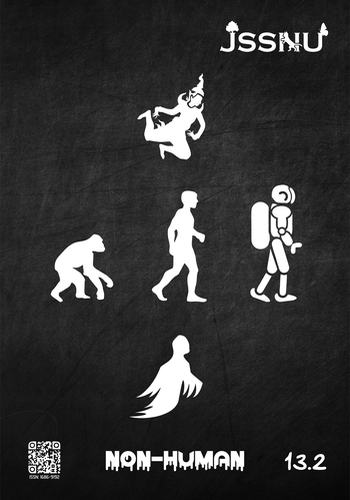Ontological Pluralism in the Parallelism between Animal and Human
Main Article Content
Abstract
The modernity, which is based on naturalism, separates humans from animals. The relationship between humans and animals is fixed in a hierarchical fashion. Human beings are in a higher than animals. The emergence of naturalism, as an ontology, has allowed man to establish himself as a Subject, and animals are pushed into just objects. According to the paper “Why Look at Animals?” John Bergerchallenges the naturalist orthodoxy by suggesting that, before the modern time, human-animal relations are parallelism, but, in modern science, the parallel life of human-animal was pushed aside by the idea of naturalism. Parallelism is The condition where both animals and humans are both strangers to each other. But at the same time, they exist and depend on each other. Human cannot hold his authority over animals in parallelism. In order to make sense of the concept of parallelism, this article aims to present ontological pluralism that focuses on non-human beings as Subject, especially animals. When the animal has the status of an actor with their own will as human, animals and humans can live in the same cultural world. It is not necessary to reduce the animal to be the only natural creature in a naturalistic way. Humans can never establish complete power over animals. The parallelism between humans and animals has appeared in the modern world in many different ways. The concept of ontological pluralism, proposed by Philippe Descola, might help solve this problem.
Downloads
Article Details
References
เก่งกิจ กิติเรียงลาภ. (2560). Perspective: ภววิทยาแบบมุมมองนิยมและความเป็น ซับเจค. เชียงใหม่: Turn.
โกมาตร จึงเสถียรทรัพย์. (2559). ศาสตร์-อศาสตร์: มานุษยวิทยา ณ จุดเปลี่ยนทางภววิทยา. ศาสตร์ อศาสตร์: เข้ามาข้างนอก ออกไปข้างใน ใน จันทนี เจริญศรี (บก.) นนทบุรี: ภาพพิมพ์.
พนา กันธา. (2560a). “หมา”: ประวัติศาสตร์ว่าด้วยสัตว์เลี้ยงที่ไม่ใช่แค่การเลี้ยงสัตว์.
วารสารประวัติศาสตร์, 42: 166-182.
พนา กันธา. (2560b). เมื่อเราต่างก็ดำรงอยู่: ภววิทยาแบบวิญญาณนิยมในโลกคู่ขนานระหว่างสัตว์กับมนุษย์. เอกสารประกอบการประชุมวิชาการระดับชาติ เวทีวิจัยมนุษยศาสตร์ไทย ครั้งที่ 11 “เปิดโลกสุนทรีย์ในวิถีมนุษยศาสตร์”. 8-9 กันยายน 2560 มหาวิทยาลัยศรีนครินทรวิโรฒ ประสานมิตร, 618-630.
มาลี สร้อยพิสุทธิ์. (2559). หูตั้ง หมาระลึกชาติ. กรุงเทพฯ: อมรินทร์ธรรมะ อมรินทร์พริ้นติ้งแอนด์พับลิชชิ่น.
รมณ ชมปรีดา. (2548). โลกของคนเลี้ยงหมา “แบบไฮโซ”: รูปธรรมของการบริโภคยุคโลกาภิวัตน์. วิทยานิพนธ์สังคมวิทยาและมานุษยวิทยามหาบัณฑิต. คณะสังคมวิทยาและมานุษยวิทยา มหาวิทยาลัยธรรมศาสตร์.
ส. พลายน้อย. (2541). สัตวนิยาย. กรุงเทพฯ: รวมสาส์น.
สายพิณ ศุพุทธมงคล. (2560). ไปสวนสัตว์ ดู(สวน)สัตว์. สิงสาราสัตว์: มานุษยวิทยาว่าด้วยสัตว์และสัตว์ศึกษา ใน สุดแดน วิสุทธิลักษณ์ (บก.) กรุงเทพฯ: มูลนิธิเพื่อการศึกษาประชาธิปไตยและการพัฒนา (โครงการจัดพิมพ์คบไฟ), 151-200.
เอกชัย เอื้อธารพิสิฐ. (2545). สวนสัตว์: มายาคติว่าด้วยธรรมชาติและสัตว์ป่า. วิทยานิพนธ์สังคมวิทยาและมานุษยวิทยามหาบัณฑิต. คณะสังคมวิทยาและมานุษยวิทยา มหาวิทยาลัยธรรมศาสตร์.
Translated Thai References
Chompreeda, R. (2005). The world of "high-society" dog caring: Form of consumption in globalization. (MA. Thesis in Sociology and Anthropology, Thammasat University).
Chuengsatiansup, K. (2016). Science - (non)Science: Ontological Turn in Anthropology. In Chantanee Charoensri (ed.), Science-(non)Science: Beyond Boundaries. Nontaburi: Paragraph Publishing.
Eutanpisit, E. (2002). Zoo: myth of nature and wildlife. (MA. Thesis in Sociology and Anthropology, Thammasat University).
Kantha, P. (2017a). “Dog”: On the History of Pet. Journal of History, 42: 166- 182.
Kantha, P. (2017b). When Each of Us Exists: Animic Ontology in Parallelism Between Animal and Human. A Paper Presented at the National Academic Conference of Thai Human Resources Research 11th “Exploring Aesthetic Dimensions in the Humanities”. 8-9 September 2017 at Srinakharinwirot University (Prasarnmit Campus), 618-630.
Kitirianglarp, K. (2017). Perspective: Ontological Perspectivism and the Subject Formation. Chiang Mai: Turn.
Plainoi, S. (1998). Animal Mythology. Bangkok: Ruamsarn.
Soipisut, M. (2016). “Hoo Tang”: A Dog Who Can Recall Its Past Life. Bangkok: Amarin Dhamma, Amarin Printing and Publishing.
Suputthamongkol, S. (2017). Going to the Zoo, Looking at the Animal. In Suddan
Wisudthiluck (ed.), Animal Kingdom: Anthropology of Animals and Animal Studies (p.151-200). Bangkok: Kobfai.
เอกสารภาษาต่างประเทศ
Anderson, Kay. (1998). Animals, Science and Spectacle in the City. In Jennifer R. Wolch and Jody Emel (Eds.), Animal Geographies: Place, Politics and Identity in the Nature-Culture Borderlands (pp.27-50). London and New York: Verso.
Arhem, Kaj. and Sprenger, Guido. (2016). Animism in Southeast Asia. London and New York: Routledge
Berger, John. (1973). Ways of seeing. London: British Broadcasting Corporation and Penguin Books.
Berger, John. (2009). Why look at Animals?. London: Penguin Book.
Bruce, Gary. (2017). Through the Lion Gate: The History of the Berlin Zoo. New York: Oxford University Press.
Cowie, Helen. (2014). Exhibiting Animals in Nineteenth-Century Britain: Empathy, Education, Entertainment. London: Palgrave Macmillan.
Descola, Philippe. (2013). Beyond Nature and Culture (Jenet Lloyd, trans). Chicago: University of Chicago Press.
Descola, Philippe. (2014). Beyond Nature and Culture. In Graham Harvey (Ed.), The Handbook of Contemporary Animism (pp.77-91). London and New York: Routledge.
Geertz, Clifford. (1973). Deep Play: Notes on the Balinese Cockfight. The interpretation of cultures : selected essays (pp. 412-453). New York: Basic Books.
Harvey, Graham. (2014a). The Handbook of Contemporary Animism. London and New York: Routledge
Harvey, Graham. (2014b). Introduction. In Graham Harvey (ed.), The Hand book of Contemporary Animism (pp. 1-12). London and New York: Routledge.
Ingold, Tim. (1980). Hunters, pastorialists and ranchers: Reindeer economies and their transformations. Cambridge: Cambridge University Press.
Kohn, Eduardo. (2013). How Forests Think: Toward an Anthropology beyond the Human. Berkeley and London: University of California Press.
Pepperberg, Irene. (2008). Alex & Me: How a Scientist and a Parrot Discovered a Hidden World of Animal Intelligence-and Formed a Deep Bond in the Process. New York: Harper Collins.
Redmalm, David. (2013). An Animal Without an Animal Within: The Power of Pet Keeping. Repro: Orebro University.
Ritvo, Harriet. (1987). The Animal Estate: The English and Other Creatures in the Victorian Age. Cambridge: Harvard University Press.
Ryan, Derek. (2015). Animal Theory: A Critical Introduction. Edinburgh: Edinburgh University Press
Sanders, Clinton R. (1999). Understanding Dogs: Living and Working with Canine Companions. Philadelphia: Temple University Press.
Sanders, Clinton R. (2003). Actions Speak Louder than Words: Close Relationships between Humans and Nonhuman Animals. Symbolic Interaction 26 (3): 405-426.
Thomas, Keith. (1984). Man and the Natural World: Changing Attitudes in England1500–1800. Harmondsworth: Penguin.
Tuan, Yi-Fu. (1984). Dominance and Affection: The Making of Pets. New Haven and London: Yale University Press.
Tylor, Edward B. (1958). Primitive culture. New York: Harper.
Viveiros de Castro, Eduardo. (2014). Cannibal Metaphysics: For a Post- Structural Anthropology (Peter Skafish, trans). Minneapolis: Univocal.


